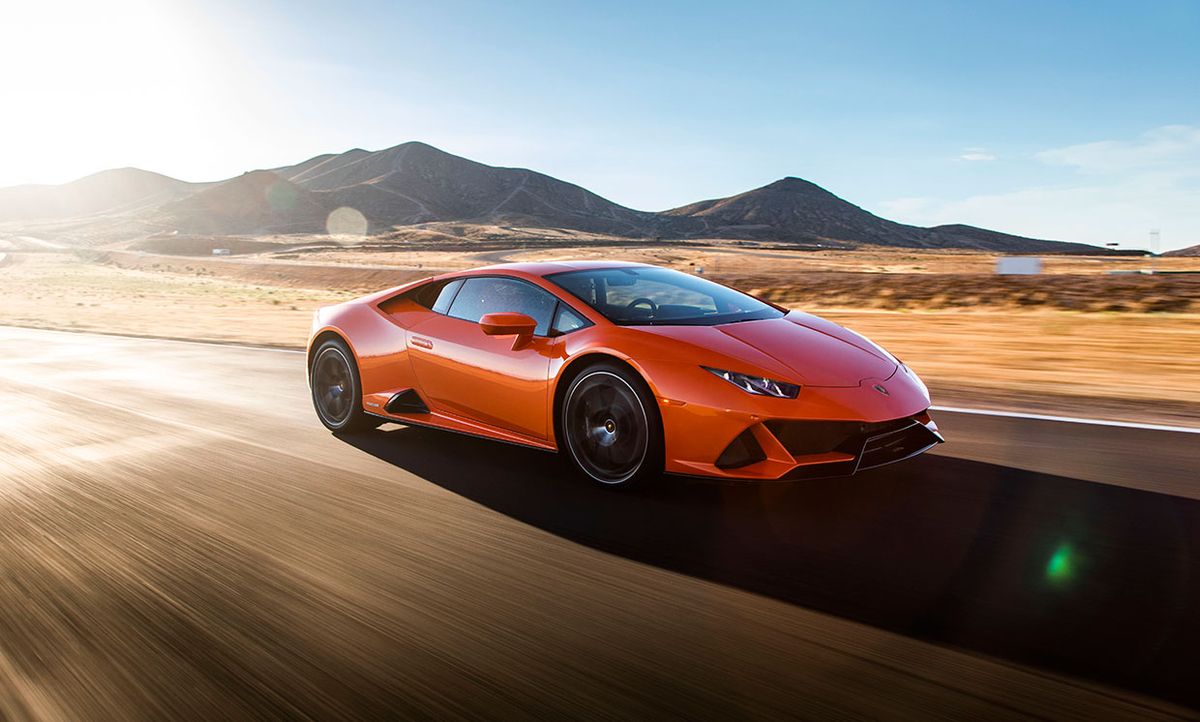Advanced Driver Assistance Systems (or “ADAS”) tend to be about slowing drivers down: braking cars automatically, or preventing errant maneuvers into looming obstacles. But Lamborghini is helping drivers go faster, via the new digital wingman in its latest supercar, the Huracan Evo.
With a 5.2-liter, naturally aspirated V-10 engine at the center of its alluring body, the Huracan produces a bellowing 640 horsepower. That power plant, and a light-but-strong chassis formed from aluminum and carbon fiber, let the supercar go from zero to about 100 kilometers per hour (60 mph) in 2.9 seconds; its top speed is a heady 325 km/h (202 mph). Strapped aboard this $265,000 Italian bull, some drivers will want all the help they can get.
I first tested the Huracan at Willow Springs International Raceway in California. The track’s historic “Big Willow” circuit—with just nine turns over 2.5 miles, roller-coaster elevation changes, and infamously high speeds—was a fine proving ground for the Lambo’s newly integrated systems.
Like many modern supercars, the Huracan is obsessed with getting all that engine power to the pavement as safely and efficiently as possible: The Huracan features a slick “torque vectoring” all-wheel-drive unit that can instantly apportion power to any of its wheels. All-wheel-steering can automatically turn the rear wheels either in opposition to the fronts, to boost agility at lower speeds, or in tandem with front wheels to aid high-speed stability.
But the Huracan’s big new brain is the real advance. The company calls it LDVI, for Lamborghini Dinamica Veicolo Integrata. That’s a mouthful, but LDVI is actually a powerful central processor that analyzes a driver’s behavior, compares it against feedback from onboard sensors and systems, and combines it all to keep the car on the pilot’s intended path. This happens even at the extremes of speed, when one wrong move might otherwise send the car spinning into a ditch.

That onboard tech includes a comprehensive set of gyroscopes and accelerometers, located at the car’s center of gravity. They measure the car’s acceleration along lateral, longitudinal and vertical axes, as well as the body’s roll, pitch, and yaw rates. The latest version of Lamborghini’s magnetic suspension continuously adjusts the dampers at all four corners in response to data from those dynamic sensors. And the brand’s familiar “ANIMA” controller lets drivers select Strada (street), Sport, or Corsa (track) modes that change the car’s driving personality.
Previously, Lamborghinis could only react passively to the driver’s inputs to the steering wheel, throttle and brakes, and make adjustments in a familiar feedback loop. But the new LDVI applies “feed forward” logic so that it’s no longer simply reacting, but actually predicting the ideal set-up for the moment to come. Driver inputs are processed in real-time, and systems are adjusted in lightning-quick, 20-millisecond increments. External conditions are monitored via the aforementioned sensors that measure tire grip and cornering forces at all four wheels, and feedback from the active suspension.
The result is a supercar with a sixth sense for the person behind its wheel and for the situations it’s encountering. The basic Strada set-up is ideal for newbies or a chill commute. Here, the digital nannies won’t allow injudicious lead-footing: A clumsy pilot’s demand for, say, more acceleration when he’s already dialed in too much steering on a corner will be met with countervailing forces to quickly right the ship. But dial the Huracan to Sport mode, and the Lamborghini is primed for Fast and Furious hijinks, allowing a skilled driver freedom to slide sideways and otherwise push the handling envelope. In Corsa mode, everything is buttoned down for the track with the aim of achieving the fastest possible lap times. Among the adjustments is diverting more power to front wheels to maximize traction and balance. Lamborghini data shows that LDVI allows drivers to carve a faster, more-efficient path through curves, with fewer human steering corrections.
Of course, some drivers—count me among them—enjoy being in full control and having to correct their own mistakes. For the most part, LDVI does work transparently and behind the scenes: Unlike primitive stability and traction systems of 20 years ago, you never get the sense that the car is withholding full power or dumbing down the experience. My one quibble was with the operation of the active rear steering, which sometimes seemed to tweak the car’s cornering attitude when I wasn’t looking for help, thank you very much. But moments of obtrusiveness aside, LDVI advances the modern supercar, and that’s a great thing. Its smarts make high performance fun, safe, and accessible—including for image-conscious buyers who have more money than driving talent.
Lawrence Ulrich is an award-winning auto writer and former chief auto critic at The New York Times and The Detroit Free Press.



